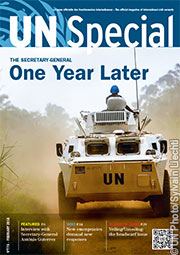GCPEA News
How to protect students, teachers, and schools in war
UN Special, February 14, 2018
By Diya Nijhowne, Executive Director of GCPEA
Education is a frequent casualty of armed conflict that affects children, their families, and their communities. In wars around the world, both indiscriminate and targeted attacks on students, teachers, schools, and universities are carried out by state armed forces and non-state armed groups for a variety of reasons – political, ethnic, cultural, or religious.
One reason schools and universities are attacked is because they are often used for military purposes, such as bases, barracks, firing positions, armories, and detention centers. Once such military use occurs, under humanitarian law, schools can lose their civilian status and become legitimate military targets – placing them at risk of attack by opposing forces.
Research conducted by the Global Coalition to Protect Education from Attack (GCPEA) has shown that, since 2013, 20 or more attacks on education have occurred in at least 28 countries worldwide. In the same period, schools and universities have been used for military purposes in 29 countries experiencing armed conflict and insecurity.
In March 2018, diplomatic missions and international and non-governmental organizations in Geneva will have at least three opportunities to improve the protection of education for children living in conflict.
First, the Human Rights Council will hold a high-level panel discussion with the Independent International Commission of Inquiry on Syria focusing on ongoing violations against children in Syria, including attacks on schools.
Second, the Special Representative of the Secretary-General for Children and Armed Conflict, Virginia Gamba, will update the Human Rights Council on the threats faced by children who are living through war.
And, third, the Human Rights Council will draft a resolution on the rights of children in humanitarian situations.
These events present important opportunities for states and organizations in Geneva to raise awareness of the problem of attacks on schools and their military use.
At the high-level panel and the Interactive Dialogue with SRSG Gamba, diplomats in Geneva should ensure that their governments issue strong statements demonstrating a clear commitment to protect students, teachers, and schools from the effects of war. Even better, the statements could outline concrete steps governments are taking to enhance these protections.
In the resolution on the rights of children in humanitarian situations, the Human Rights Council should recognize the importance of education as a basic need and a protective, life-saving intervention, especially for children affected by conflict. The resolution should call on states to integrate education into their humanitarian response plans, provide adequate funding to support continued education in emergencies, and increase the physical safety and security of schools to protect students and teachers from attack. Finally, the resolution should recognize that the military use of educational infrastructure is often a key reason that schools are attacked, and should call on states to take steps to restrict and deter the practice.
Children continue to pay the heaviest price of attacks on schools, which leave them unable to learn or fulfil their potential. This is why the governments of Argentina and Norway champion the Safe Schools Declaration, an inter-governmental political commitment aimed at enhancing the protection of education during armed conflict.
Seventy-two countries have already endorsed this Declaration, and by doing so, committed to take a range of actions to safeguard learning during armed conflict, including by monitoring and reporting attacks, assisting victims, and supporting the continuation of safe education during war. By joining the Safe Schools Declaration, states also commit to limit the use of schools and universities for military purposes.
In May 2017, the United Nations Secretary-General, António Guterres, urged all UN member states to endorse this Declaration. SRSG Gamba echoed his call, observing that the increasing support for the Declaration reflects a growing international consensus that reducing military use of educational buildings is essential to avoid the disruption of education.
The Safe Schools Declaration is already making a positive difference. Countries such as Denmark and New Zealand have updated their military manuals to include special protections for education and limit the military use of schools, and Switzerland is in the process of a similar update. Slovenia has incorporated new protections into its training materials for international operations. Ecuador is revising the training curriculum for members of its armed forces to incorporate stronger protections for educational infrastructure.
Countries that are directly affected by conflict have also been using the Safe Schools Declaration as a framework for improving protection of education. The Ministry of Education in Afghanistan has been taking steps to put an end to the military use of schools, using the Declaration to advocate for the removal of military checkpoints and bases from education centers. South Sudan and Niger are developing conflict-sensitive education policies to address and prevent potential causes of conflict. African Union forces have vacated schools and universities they were using as bases in Somalia. UN peacekeepers in the Central African Republic have cleared schools occupied by non-state armed groups. And authorities in Nigeria and Palestine have been implementing a range of safety and security measures designed to make schools safer even in the most difficult of circumstances.
Since the Declaration was opened for endorsement in Oslo in May 2015, GCPEA has been collecting these and other examples of implementation, which are detailed in a recent publication called “The Safe Schools Declaration: A Framework for Action”. This tool provides governments with recommendations and advice on how to implement the Declaration.
With next month’s program of activities in Geneva offering many opportunities for states to demonstrate their commitment to improve protection for children in conflict, one concrete step that states can take is to endorse the Safe Schools Declaration and join the community of states already working to make schools safer during war.





